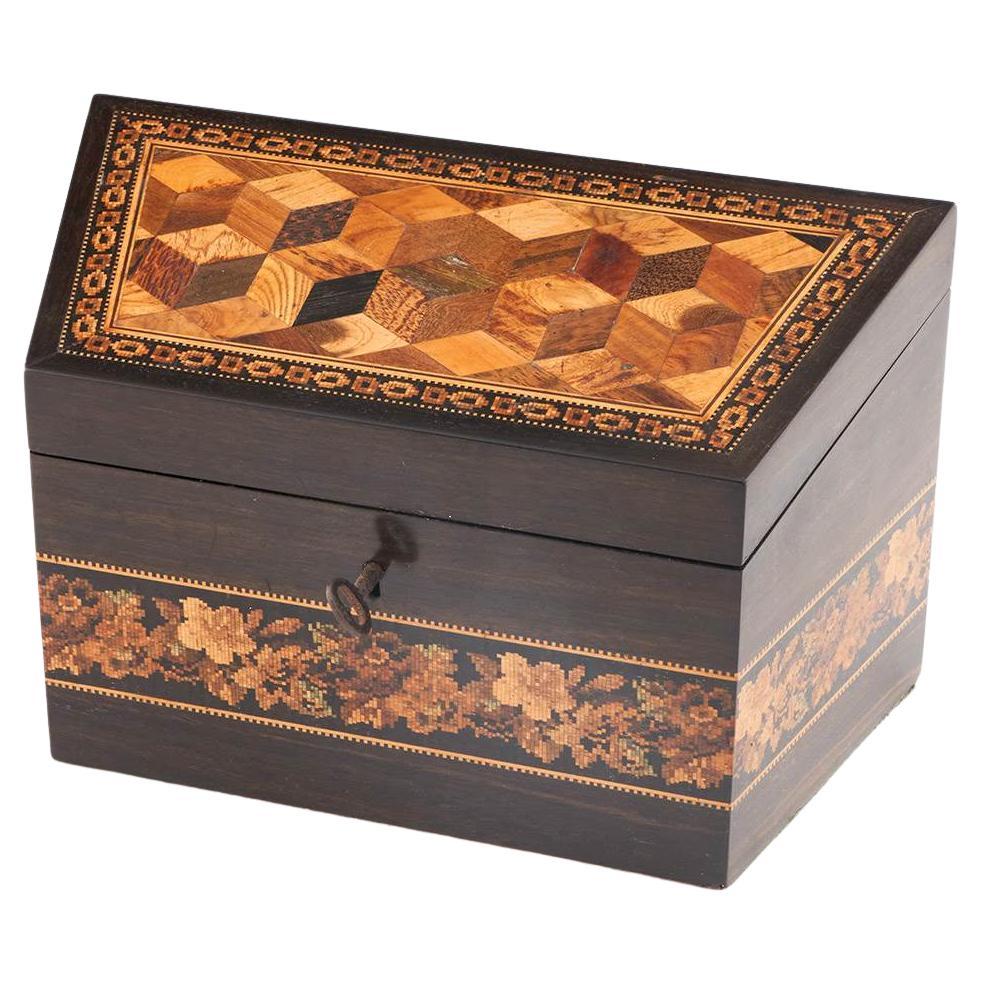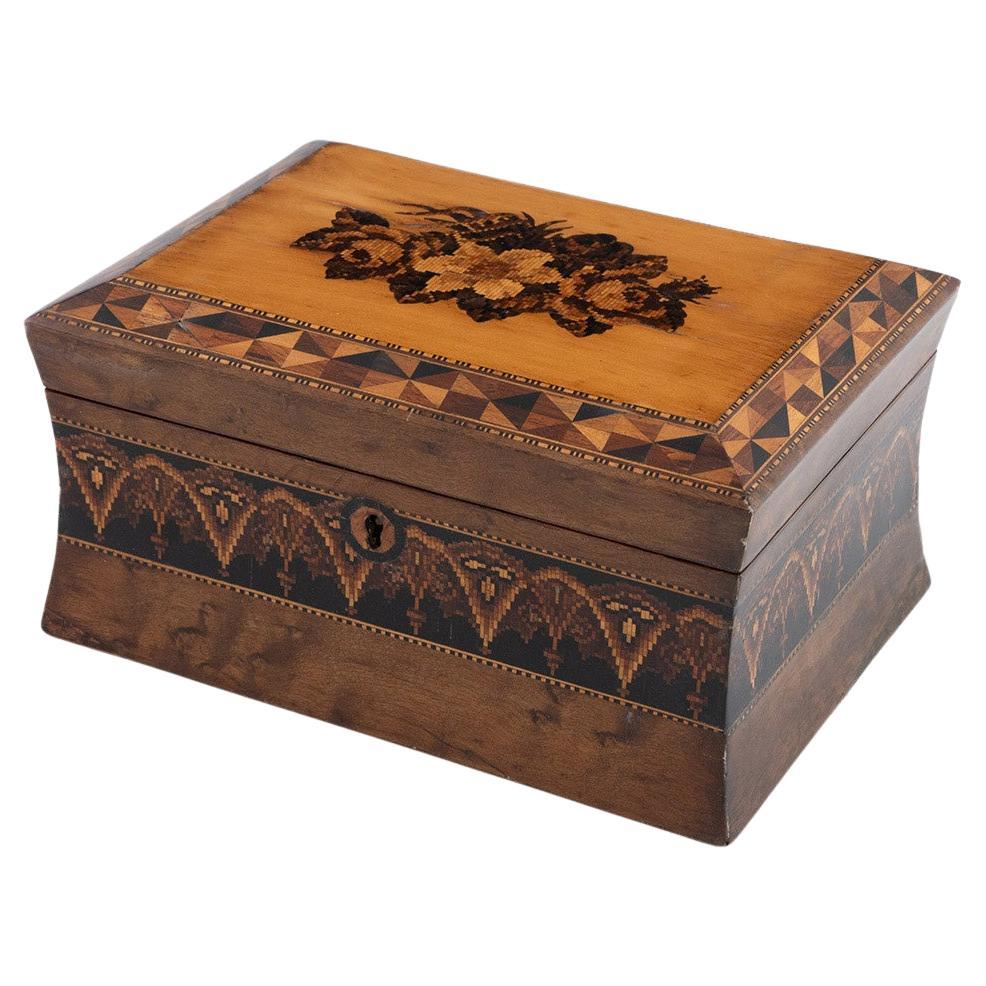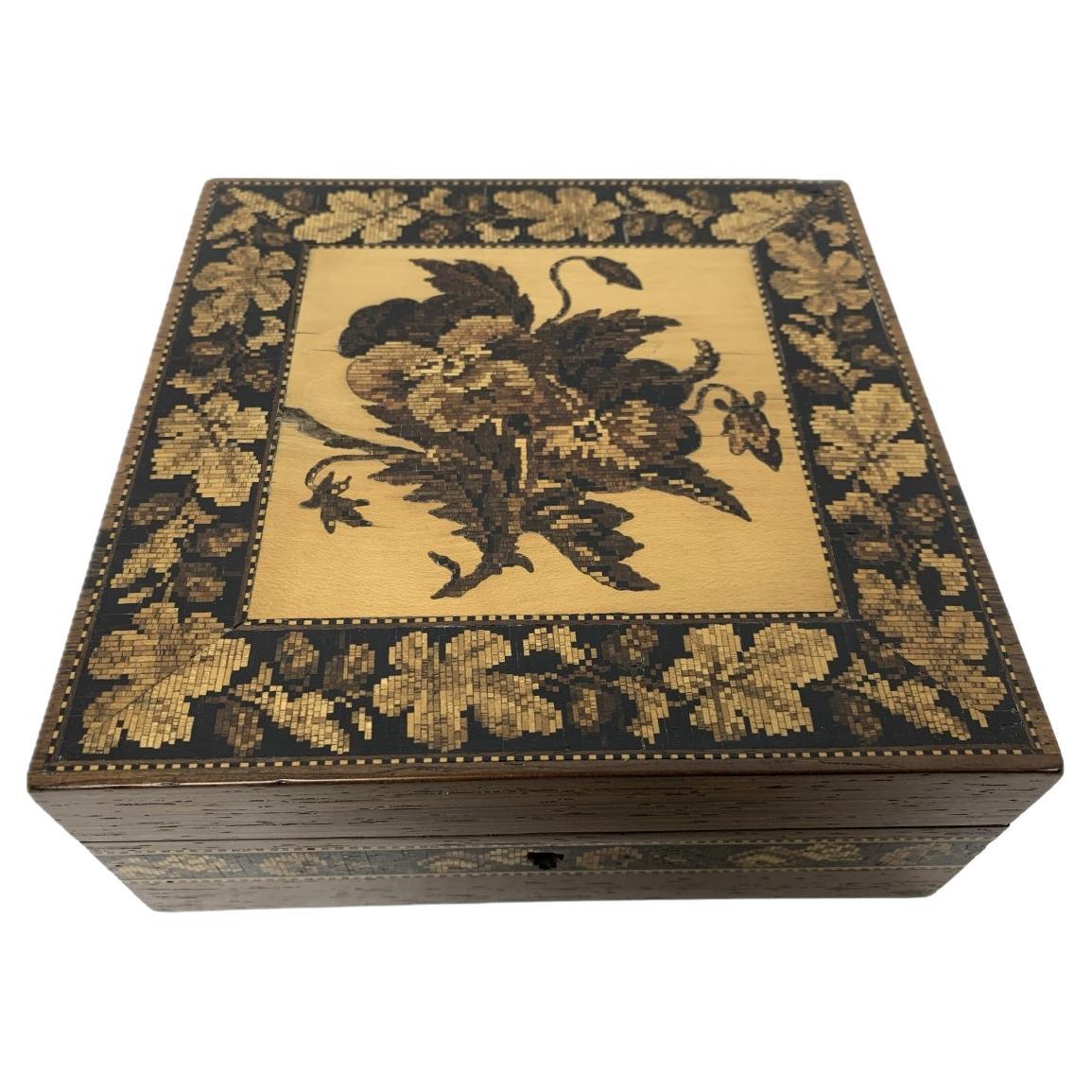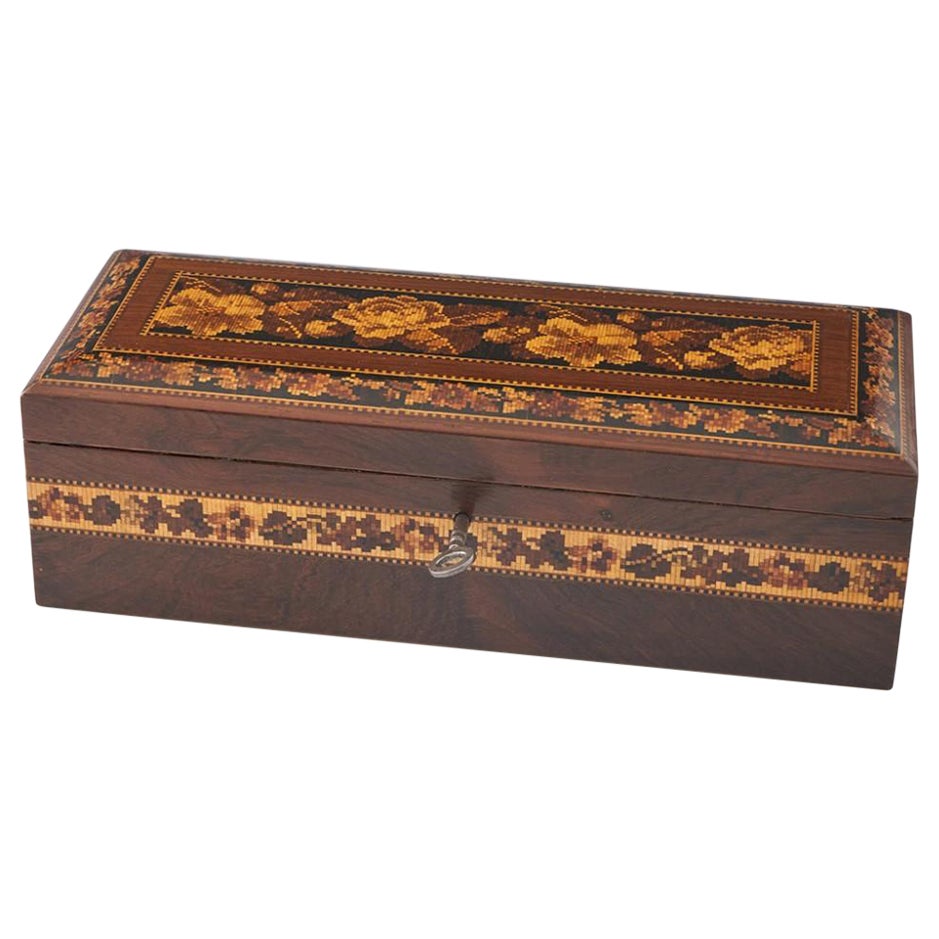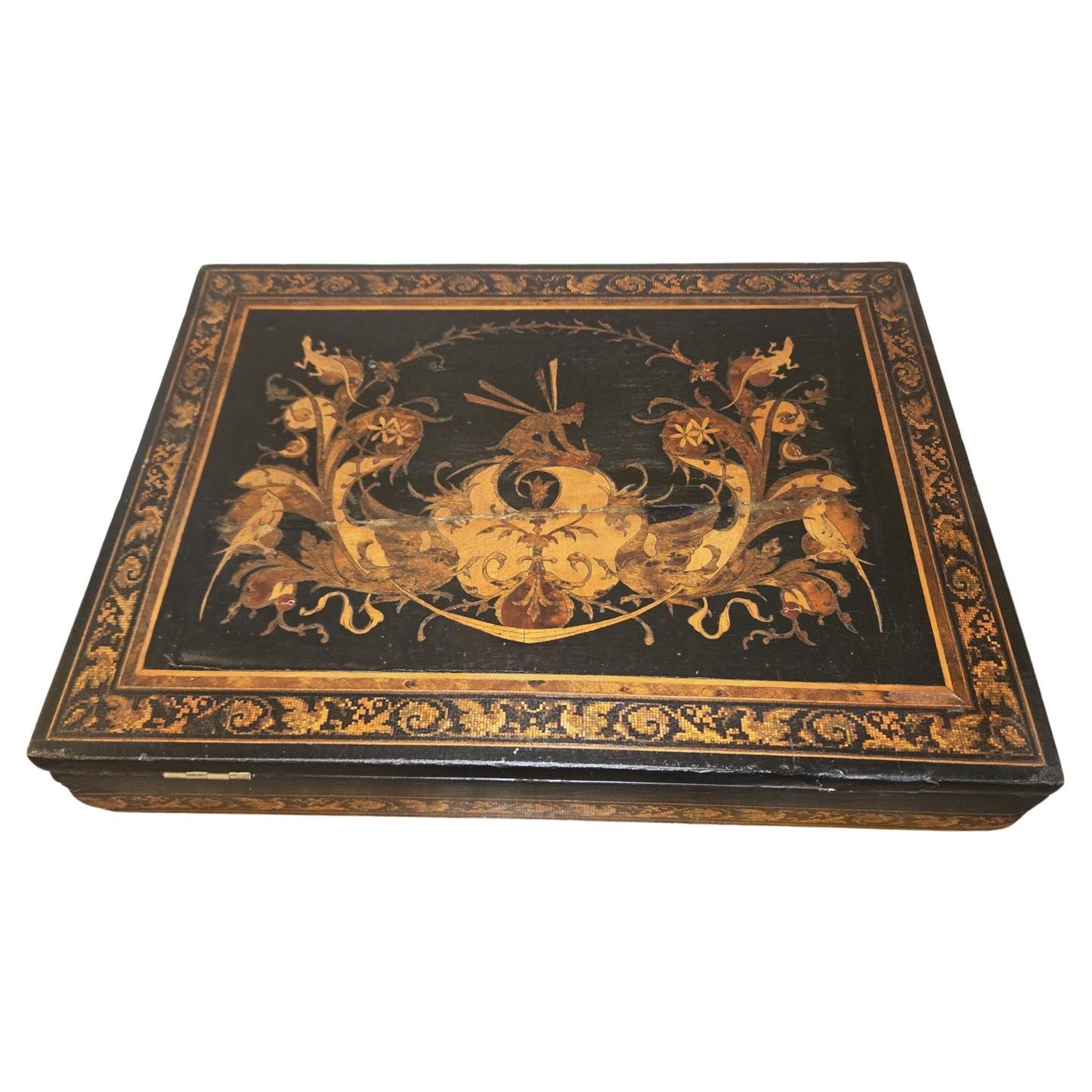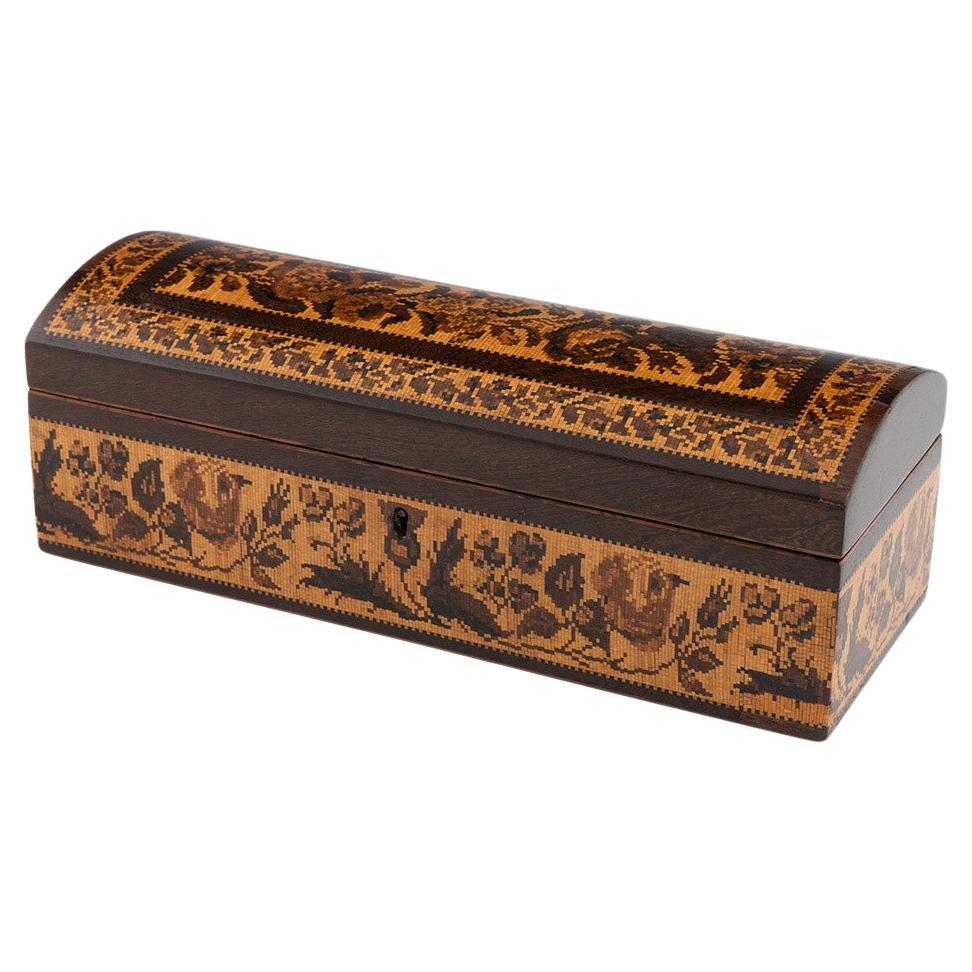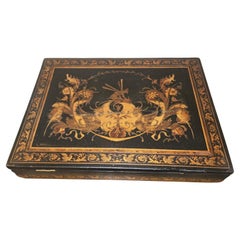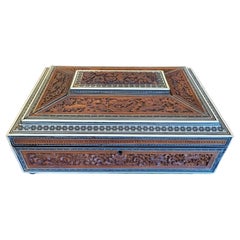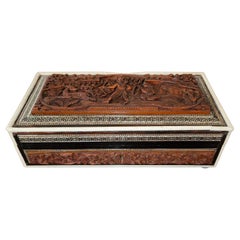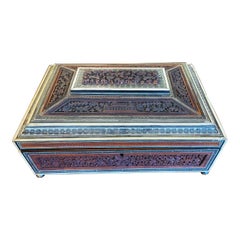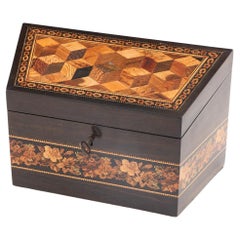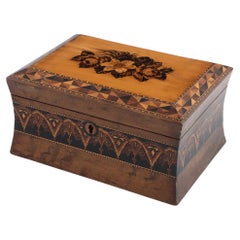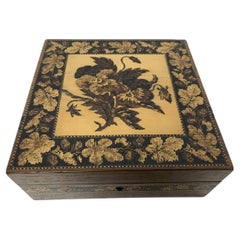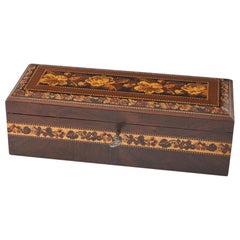Items Similar to 19C English Tunbridgeware Tabletop Stationary Box, Micro Mosaic
Want more images or videos?
Request additional images or videos from the seller
1 of 10
19C English Tunbridgeware Tabletop Stationary Box, Micro Mosaic
$860
£671.73
€761.48
CA$1,232.91
A$1,352.43
CHF 707.61
MX$16,096.62
NOK 8,937.58
SEK 8,383.61
DKK 5,687.19
About the Item
Stunning little 19th century tabletop stationary box made of micro-mosaic.
Made in Britain, circa 1870, in Tunbridge Wells, hence these type of works are called Tunbridgeware!
Tunbridge ware is a form of decoratively inlaid woodwork, typically in the form of boxes, that is characteristic of Tonbridge and the spa town of Tunbridge Wells in Kent in the 18th and 19th centuries. The decoration typically consists of a mosaic of many very small pieces of different colored woods that form a pictorial vignette. Shaped rods and slivers of wood were first carefully glued together, then cut into many thin slices of identical pictorial veneer with a fine saw. Elaborately striped and feathered bandings for framing were pre-formed in a similar fashion.
The micro-mosaic is made up of thousands of tiny pieces of wood, in various colors, assembled to form an inlay and geometric pattern on the box.
This box has a micro-mosaic floral design as its central motif. It is banded on the lid and sides with more gorgeous micro-mosaic patterns.
The box itself is probably made of a combination of boxwood and raw mahogany. The wooden case is clearly irrelevant as the beauty of this piece is in its micro-mosaic overlay.
The interior is lined in its original burgundy colored red velvet and vinyl.
The interior of the lid doubles as a small writing slope.
The interior has 5 compartments, one for an inkwell (this has the original inkwell in it) and 2 with the original covers (you can really appreciate the original color on these lids. 2 open compartments.
The compartments lift off to reveal more storage underneath, for pens, etc. Again, in original condition.
This piece is in great condition having regard to its age, use and construction. It retains almost all of its original mosaic which is miraculous for these types of pieces.
- Creator:Tunbridge Ware (Maker)
- Dimensions:Height: 2.25 in (5.72 cm)Width: 10 in (25.4 cm)Depth: 6.75 in (17.15 cm)
- Style:High Victorian (Of the Period)
- Materials and Techniques:
- Place of Origin:
- Period:
- Date of Manufacture:1870
- Condition:Wear consistent with age and use. Minor fading. This piece is in great condition having regard to its age, use and construction. It retains almost all of its original mosaic, miraculous for these types of pieces.
- Seller Location:Dallas, TX
- Reference Number:1stDibs: LU3978112110481
About the Seller
4.9
Gold Seller
Premium sellers maintaining a 4.3+ rating and 24-hour response times
Established in 2015
1stDibs seller since 2018
397 sales on 1stDibs
Typical response time: <1 hour
- ShippingRetrieving quote...Shipping from: Dallas, TX
- Return Policy
More From This Seller
View All19C British Tunbridgeware Micro-mosaic Lap Desk - RARE
Located in Dallas, TX
PRESENTING an ABSOLUTELY GORGEOUS and EXTREMELY UNIQUE and RARE 19C British Tunbridgeware Micromosaic Lap Desk.
This lap desk is unlike any of it’s kind we have seen before.
From c...
Category
Antique Mid-19th Century English High Victorian Decorative Boxes
Materials
Boxwood, Maple, Walnut
19C Anglo Indian Highly Carved Sadeli Mosaic Sarcophagus Sewing Box
Located in Dallas, TX
PRESENTING A GORGEOUS 19C Anglo Indian Highly Carved Sadeli Mosaic Sarcophagus Sewing Box.
Made in Bombay, India circa 1860-80.
Box made of sandalwood with highly carved teak wood reliefs and panels on all sides.
Edged with bone and ebony veneers and glorious sadeli mosaic, made from tiny pieces of faux ivory, pewter, green semi-precious stone.
The box is in a sarcophagus form with domed lid.
The original brass carry handles are on the sides.
The interior is in great condition and consists of a removeable mirror under the lid portion, with the original red velvet lining behind it.
The base is removeable and contains a number of lidded compartments.
6 of the interior lids on the base, are each inlaid with sadeli mosaic banding. The rest are also carved and chased.
The interior is fully complete with 7 lidded faux ivory/bone, thread canisters with sadeli domes and the original bone thimble.
The box sits on 4 brass ball or bun feet with the original velvet lining on the base.
Some minor repairs and losses, but this box is fully complete. This is ‘rare’ as many of these boxes have not survived in such condition!
Included in the sale are 2 photos that were in the box (under the base tray). Interestingly, one of them is a view of downtown Nassau, New Providence (Bermuda) from the early 20C and stamped on the rear. What a ‘journey’ this piece has made! Made in India … travelled to Bermuda, probably via Britain … back to Ireland (where we bought it) …. then to Texas!
These boxes were made by superb Indian craftsmen, specifically for sale to the ruling British elite. These types of boxes, carved padouk and sandalwood, (whilst beautiful and superbly crafted) were of a lesser quality, than the more profusely and intricately mosaic inlay, tortoiseshell and ivory boxes, made for the British ‘Upper Classes’ in the areas of Bombay and Vizagapatam. These type of boxes were much more affordable back in 1880 (and indeed today) and would probably have been bought by mid-level diplomats, civil servants or visitors.
Sewing boxes (in general), were in EVERY Victorian home in Britain in the 19th Century and like other boxes etc were ‘status symbols’ of your place in society! The more ornate the box, the more ‘Upper Class’ you were!
Of it’s type, this one, is one of the very higher quality one’s, than the norm!
SADELI MOSAIC: “Anglo Indian boxes were made in India for the English residents from the early part of the 18th century. They were brought back or sent back to England usually by the people who had commissioned them. From the beginning of the nineteenth century they were imported more commercially, although not in any significant numbers until the middle decades. They were very highly valued, especially the early ones, to the extent that the designs were copied on late 19th and early 20th century tins.
The ancient art of Sadeli Mosaic is said to have been introduced from Shiraz in Persia via Sind to Bombay, a long time before the Anglo Indian boxes were made. It was a technique, which required a high degree of skill and patience. It was executed very lavishly, in that the frequent cuts wasted a great amount of the precious materials used. The workmanship was however more than commensurable to the value of the materials.
Ivory, silver, pewter (or other metals), wood and horn were cut into faceted rods which were bound together to form geometric patterns. When the glue has set, the rods were sliced in transverse sections. This gave the maker a number of angled circular pieces in the original pattern. Several variations of patterns could be achieved by combining the materials in different ways. The ivory was sometimes dyed green to give an extra color.
The mosaic pieces in a combination of patterns, often separated by ivory, ebony, horn or silver stringing were used to veneer sandalwood boxes. In the early boxes, which date from the turn of the 18th to the 19th century, there are large panels of mosaic covering tops and sides of boxes. It took incredible skill to cover such large areas without any shakes or wavering of the pattern. The corners and joins on these boxes are impeccably matched.
The makers (reputed to be Persian) of Sadeli mosaic made in the first two decades of the 19th century displayed a total understanding of the qualities of the different materials they used. They combined substances, which can expand and contract according to atmospheric conditions with others, which are hard and unyielding. The result was a sharp definition of the lines and patterns, which made up the whole design.
On the early boxes the designs look deceptively simple. The fact is, they emerged from a culture, which had mastered geometry and understood how to generate a pattern from a set number of points. The patterns are so harmoniously combined that their incredible complexity is not immediately apparent.
The earliest Sadeli boxes...
Category
Antique 19th Century Indian Anglo-Indian Decorative Boxes
Materials
Bone, Sandalwood, Teak
19C Anglo Indian Carved Teak Wood and Sadeli Mosaic Box
Located in Dallas, TX
PRESENTING A LOVELY 19th century Anglo-Indian Carved Teak Wood and Sadeli Mosaic Box, featuring a carving of a Hunt Scene.
Made circa 1870 in Bombay, India during the Rule of the Br...
Category
Antique Late 19th Century Indian Anglo-Indian Jewelry Boxes
Materials
Silver, Pewter
19C Anglo Indian Highly Carved Teak Sadeli Mosaic Inlaid Sewing Box
Located in Dallas, TX
PRESENTING A LOVELY 19C Anglo Indian Highly Carved Sadeli Mosaic Inlaid Sewing Box.
Made in Bombay, India, circa 1880.
The box is made of sandalwood with highly carved raised teak wood panels on all sides, depicting temple scenes, animals and foliage.
The box is in a sarcophagus form.
It is edged in bone (and we can tell it is bone and not ivory, from the color and evidence of capillaries, which are not found in ivory), and banded with Bombay Sadeli mosaic and ebony veneer.
The lid opens to reveal a removable tray with various open compartments and lidded compartments. 5 lidded compartments, 1 unlidded compartment and 8 holders for thimbles, etc
The tray lifts to reveal a blue velvet (original) lined section, for storing jewelry etc, with sections for collars etc.
The inside of the lid has a removable mirror (the mirror is missing on this one but can easily be replaced). Behind the mirror is the original green velvet lining.
It has its original brass carry handles on the sides and sits on 4 silvered button feet (of recent origin).
Some repairs to the exterior and condition issues (priced accordingly), but still a LOVELY COLLECTIBLE box!
These boxes were made by superb Indian craftsmen, specifically for sale to the ruling British elite. These types of boxes, carved padouk and sandalwood, (whilst beautiful and superbly crafted) were of a lesser quality, than the more profusely and intricately mosaic inlay, tortoiseshell and ivory boxes, made for the British ‘Upper Classes’ in the areas of Bombay and Vizagapatam. These type of boxes were much more affordable back in 1880 (and indeed today) and would probably have been bought by mid-level diplomats, civil servants or visitors.
Sewing boxes (in general), were in EVERY Victorian home in Britain in the 19th century and like other boxes etc were ‘status symbols’ of your place in society! The more ornate the box, the more ‘Upper Class’ you were!
SADELI MOSAIC: “Anglo Indian boxes were made in India for the English residents from the early part of the 18th century. They were brought back or sent back to England usually by the people who had commissioned them. From the beginning of the nineteenth century they were imported more commercially, although not in any significant numbers until the middle decades. They were very highly valued, especially the early ones, to the extent that the designs were copied on late 19th and early 20th century tins.
The ancient art of Sadeli Mosaic is said to have been introduced from Shiraz in Persia via Sind to Bombay, a long time before the Anglo Indian boxes were made. It was a technique, which required a high degree of skill and patience. It was executed very lavishly, in that the frequent cuts wasted a great amount of the precious materials used. The workmanship was however more than commensurable to the value of the materials.
Ivory, silver, pewter (or other metals), wood and Horn were cut into faceted rods which were bound together to form geometric patterns. When the glue has set, the rods were sliced in transverse sections. This gave the maker a number of angled circular pieces in the original pattern. Several variations of patterns could be achieved by combining the materials in different ways. The ivory was sometimes dyed green to give an extra color.
The mosaic pieces in a combination of patterns, often separated by ivory, ebony, Horn or silver stringing were used to veneer sandalwood boxes. In the early boxes, which date from the turn of the 18th to the 19th century, there are large panels of mosaic covering tops and sides of boxes. It took incredible skill to cover such large areas without any shakes or wavering of the pattern. The corners and joins on these boxes are impeccably matched.
The makers (reputed to be Persian) of Sadeli mosaic made in the first two decades of the 19th century displayed a total understanding of the qualities of the different materials they used. They combined substances, which can expand and contract according to atmospheric conditions with others, which are hard and unyielding. The result was a sharp definition of the lines and patterns, which made up the whole design.
On the early boxes the designs look deceptively simple. The fact is, they emerged from a culture, which had mastered geometry and understood how to generate a pattern from a set number of points. The patterns are so harmoniously combined that their incredible complexity is not immediately apparent.
The earliest Sadeli boxes...
Category
Antique Late 19th Century Indian Anglo-Indian Decorative Boxes
Materials
Bone, Sandalwood, Teak
19C Anglo Indian Bombay MOP Sadeli Mosaic Trinket Box
Located in Dallas, TX
PRESENTING a LOVELY 19C Anglo Indian Bombay MOP (Mother of Pearl) Sadeli Mosaic Trinket Box from circa 1875-85.
Gorgeously detailed and hand-crafted ‘sadeli mosaic’ inlay, from the Bombay Area, with deep greens with silver, pewter, mother of pearl, bone and ebony in geometric patterns.
The box case, is made of sandalwood but completely covered in MOP, bone, faux ivory, ebony and mosaic inlay.
Edged with faux ivory and banded with a different pattern of sadeli mosaic.
Some minor damage to the top (repair is obvious in pics) and ivorine replacements to some edging, but it still a BEAUTIFUL BOX and of real QUALITY!
The mosaic work is FABULOUS!
Box opens to reveal its original blue velvet lining.
It sits on 4 (recently added) silvered button feet.
SADELI MOSAIC: “Anglo Indian boxes were made in India for the English residents from the early part of the 18th century. They were brought back or sent back to England usually by the people who had commissioned them. From the beginning of the nineteenth century they were imported more commercially, although not in any significant numbers until the middle decades. They were very highly valued, especially the early ones, to the extent that the designs were copied on late 19th and early 20th century tins.
The ancient art of Sadeli Mosaic is said to have been introduced from Shiraz in Persia via Sind to Bombay, a long time before the Anglo Indian boxes were made. It was a technique, which required a high degree of skill and patience. It was executed very lavishly, in that the frequent cuts wasted a great amount of the precious materials used. The workmanship was however more than commensurable to the value of the materials.
Ivory, silver, pewter (or other metals), wood and horn were cut into faceted rods which were bound together to form geometric patterns. When the glue has set, the rods were sliced in transverse sections. This gave the maker a number of angled circular pieces in the original pattern. Several variations of patterns could be achieved by combining the materials in different ways. The ivory was sometimes dyed green to give an extra color.
The mosaic pieces in a combination of patterns, often separated by ivory, ebony, horn or silver stringing were used to veneer sandalwood boxes. In the early boxes, which date from the turn of the 18th to the 19th century, there are large panels of mosaic covering tops and sides of boxes. It took incredible skill to cover such large areas without any shakes or wavering of the pattern. The corners and joins on these boxes are impeccably matched.
The makers (reputed to be Persian) of Sadeli mosaic made in the first two decades of the 19th century displayed a total understanding of the qualities of the different materials they used. They combined substances, which can expand and contract according to atmospheric conditions with others, which are hard and unyielding. The result was a sharp definition of the lines and patterns, which made up the whole design.
On the early boxes the designs look deceptively simple. The fact is, they emerged from a culture, which had mastered geometry and understood how to generate a pattern from a set number of points. The patterns are so harmoniously combined that their incredible complexity is not immediately apparent.
The earliest Sadeli boxes...
Category
Antique Late 19th Century Indian Anglo-Indian Jewelry Boxes
Materials
Silver
19c Anglo Indian Highly Carved Teak and Sandalwood Sarcophagus Sewing Box
Located in Dallas, TX
PRESENTING A VERY NICE 19C Anglo Indian Highly Carved Teak and Sandalwood Sarcophagus Sewing Box.
Made in Bombay, India circa 1890-1900.
The box case/body is made of sandalwood wit...
Category
Antique Late 19th Century Indian Anglo-Indian Decorative Boxes
Materials
Bone, Sandalwood, Teak
You May Also Like
Tunbridge Ware Stationery Box – Cubework and Floral Mosaic
Located in Tunbridge Wells, GB
Heading : Tunbridge Ware – Wedge-Shaped Stationery Box with Isometric Cubes and Floral Mosaic c1870
Date : c1870
Period : Victorian
Origin : Tunbridge Wells – Thomas Barton
Decoratio...
Category
Antique Late 19th Century English Victorian Decorative Boxes
Materials
Wood
Tunbridge Ware Sewing Box with Floral Mosaic c1860
By Tunbridge Ware
Located in Tunbridge Wells, GB
Heading : Tunbridge ware sewing box with floral mosaic
Date : c1860
Period : Victoria
Origin : Probably Tunbridge Wells
Decoration : Central ...
Category
Antique 1860s British Victorian Decorative Boxes
Materials
Wood
Antique Victorian Tunbridge Ware Lined Handkerchief Box
By Tunbridge Ware
Located in Bridgeport, CT
A Victorian rosewood Tunbridge ware handkerchief box with lid decorated with mosaic floral group to the centre and floral border, opening to reveal a ...
Category
Antique 19th Century English Late Victorian Decorative Boxes
Materials
Rosewood
Tunbridge Ware Pillow-topped Glove Box Box with Floral Mosaic, c1865
Located in Tunbridge Wells, GB
Tunbridge Ware Pillow-topped Glove Box Box with Floral Mosaic, c1865
Additional Information:
Heading: A Tunbridge Ware Pillow-topped Glove Box Box with Floral Mosaic
Date : c1865
Period : Victoria
Origin : Tunbridge Wells, Kent
Decoration : A low pillow-like lid with a mosaic of flowers from Golden Satinwood, within two pairs of banded and plain keylines and narrow floral pattern band. A further floral design to the sides, again within a pair of keylines
Size : 25.6 W x 10.0 D x 8.5 H cm
Condition : Excellent Condition - Key present, lock not working...
Category
Antique 19th Century English Victorian Decorative Boxes
Materials
Satinwood
Tunbridge Ware Glove Box with Floral Mosaic c1870
By Tunbridge Ware
Located in Tunbridge Wells, GB
Heading : Tunbridge Ware Glove box with floral mosaic
Date : c1870
Period : Victoria
Origin : Tunbridge Wells
Decoration : Dome topped with central woolwork floral mosaic and foliate...
Category
Antique 1870s British Victorian Decorative Boxes
Materials
Wood
Tunbridge Ware Stationery Box with Writing Slope c1860
By Tunbridge Ware
Located in Tunbridge Wells, GB
Heading : Tunbridge ware stationery box with writing slope
Date : c1860
Period : Victoria
Origin : Tunbridge Wells, Kent
Decoration : Central image of a stag, floral banding to b...
Category
Antique 1860s British Victorian Decorative Boxes
Materials
Wood
More Ways To Browse
Micro Mosaic
Antique Wooden Box With Lid Boxes
Antique Micro Mosaic
Antique Stationary
Mosaic Box
Burl Boxes
Antique Writing Slope Box Writing Slopes
Antique Tunbridge Ware
Tunbridge Wells
Tunbridge Ware Box
Antique Tunbridge Ware Boxes
Micro Mosaics 19th Century
Victorian Micro Mosaic
Micro Mosaic Box
Antique Stationary Box
Tunbridge English Boxes
19th Century Tunbridge Ware Writing Box
Antique Box Hinges
